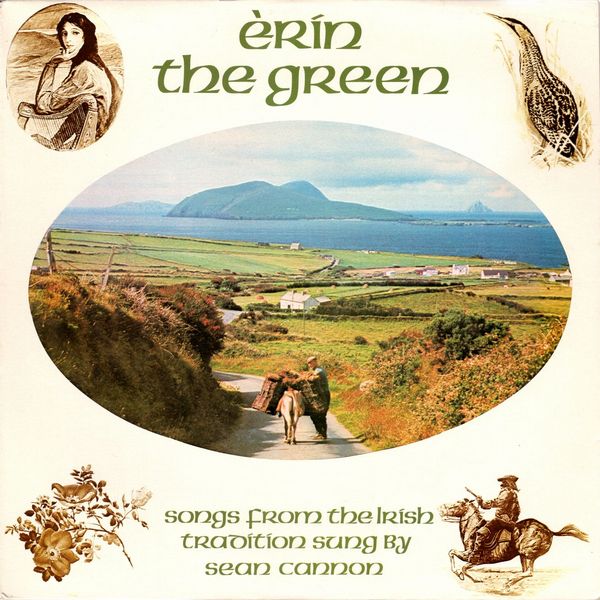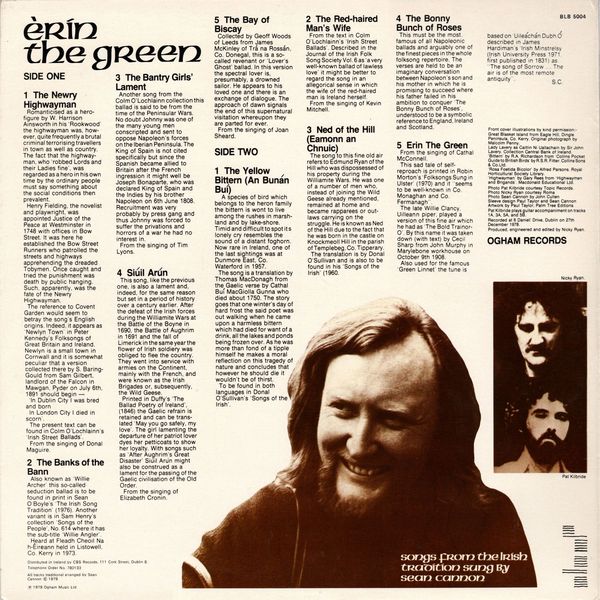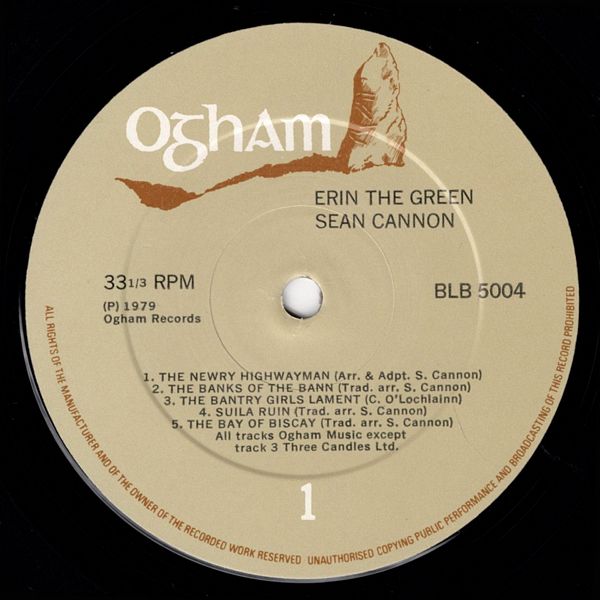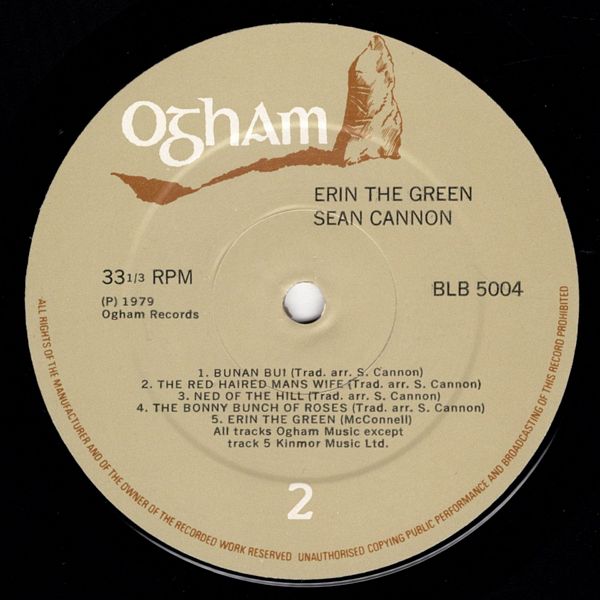

 |


 |
Sleeve Notes
The Newry Highwayman — Romanticised as a hero-figure by W. Harrison Ainsworth in his 'Rookwood' the highwayman was, however, quite frequently a brutal criminal terrorising travellers in town as well as country. The fact that the highwayman, who 'robbed Lords and their Ladies fine', was regarded as a hero in his own time by the ordinary people must say something about the social conditions then prevalent.
Henry Fielding, the novelist and playwright, was appointed Justice of the Peace at Westminster in 1748 with offices in Bow Street. It was here he established the Bow Street Runners who patrolled the streets and highways apprehending the dreaded Tobymen. Once caught and tried the punishment was death by public hanging. Such, apparently, was the fate of the Newry Highwayman.
The reference to Covent Garden would seem to betray the song's English origins. Indeed, it appears as 'Newlyn Town' in Peter Kennedy's Folksongs of Great Britain and Ireland. Newlyn is a small town in Cornwall and it is somewhat peculiar that a version collected there by S. Baring-Gould from Sam Gilbert, landlord of the Falcon in Mawgan, Pyder on July 6th, 1891 should begin —
'In Dublin City I was bred and born
In London City I died in scorn'.
The present text can be found in Colm O'Lochlainn's Irish Street Ballads'.
From the singing of Donal Maguire.
The Banks of the Bann — Also known as Willie Archer' this so-called seduction ballad is to be found in print in Sean O'Boyle's The Irish Song Tradition' (1976). Another variant is in Sam Henry's collection Songs of the People', No. 614 where it has the sub-title Willie Angler'. Heard at Fleadh Cheoil Na h-éireann held in Listowell, Co. Kerry in 1973.
The Bantry Girls' Lament — Another song from the Colm O'Lochlainn collection this ballad is said to be from the time of the Peninsular Wars. No doubt Johnny was one of the many young men conscripted and sent to oppose Napoleon's forces on the Iberian Peninsula. The King of Spain is not cited specifically but since the Spanish became allied to Britain after the French ingression it might well be Joseph Bonaparte, who was declared King of Spain and the Indies by his brother Napoleon on 6th June 1808. Recruitment was very probably by press gang and thus Johnny was forced to suffer the privations and horrors of a war he had no interest in.
From the singing of Tim Lyons.
Siúil Arún — This song, like the previous one, is also a lament and, indeed, for the same reason but set in a period of history over a century earlier. After the defeat of the Irish forces during the Williamite Wars at the Battle of the Boyne in 1690, the Battle of Aughrim in 1691 and the fall of Limerick in the same year the flower of Irish soldiery was obliged to flee the country. They went into service with armies on the Continent, mainly with the French, and were known as the Irish Brigades or, subsequently, the Wild Geese.
Printed in Duffy's The Ballad Poetry of Ireland', (1846) the Gaelic refrain is retained and can be translated May you go safely, my love'. The girl lamenting the departure of her patriot lover dyes her petticoats to show her loyalty. With songs such as After Aughrim's Great Disaster' Siúil Arún might also be construed as a lament for the passing of the Gaelic civilisation of the Old Order.
From the singing of Elizabeth Cronin.
The Bay of Biscay — Collected by Geoff Woods of Leeds from James McKinley of Trá na Rossán, Co. Donegal, this is a so-called revenant or 'Lover's Ghost' ballad. In this version the spectral lover is, presumably, a drowned sailor. He appears to his loved one and there is an exchange of dialogue. The approach of dawn signals the end of this supernatural visitation whereupon they are parted for ever.
From the singing of Joan Sheard.
The Yellow Bittern (An Bunán Buí) — A species of bird which belongs to the heron family the bittern is wont to live among the rushes in marshland and by lake-shore. Timid and difficult to spot its lonely cry resembles the sound of a distant foghorn. Now rare in Ireland, one of the last sightings was at Dunmore East, Co. Waterford in 1957.
The song is a translation by Thomas MacDonagh from the Gaelic verse by Cathal Buí MacGiolla Gunna who died about 1750. The story goes that one winter's day of hard frost the said poet was out walking when he came upon a harmless bittern which had died for want of a drink, all the lakes and ponds being frozen over. As he was more than fond of a tipple himself he makes a moral reflection on this tragedy of nature and concludes that however he should die it wouldn't be of thirst.
To be found in both languages in Donal O'Sullivan's Songs of the Irish'.
The Red-haired Man's Wife — From the text in Colm O'Lochlainn's Irish Street Ballads'. Described in the Journal of the Irish Folk Song Society Vol. 6 as a very well-known ballad of lawless love' it might be better to regard the song in an allegorical sense in which the wife of the red-haired man is Ireland herself.
From the singing of Kevin Mitchell.
Ned of the Hill (Eamonn an Chnuic) — The song to this fine old air refers to Edmund Ryan of the Hill who was dispossessed of his property during the Williamite Wars. He was one of a number of men who, instead of joining the Wild Geese already mentioned, remained at home and became rapparees or outlaws carrying on the struggle. He is known as Ned of the Hill due to the fact that he was born in the castle on Knockmeoll Hill in the parish of Templebeg, Co. Tipperary.
The translation is by Donal O'Sullivan and is also to be found in his Songs of the Irish' (1960).
The Bonny Bunch of Roses — This must be the most famous of all Napoleonic ballads and arguably one of the finest pieces in the whole folksong repertoire. The verses are held to be an imaginary conversation between Napoleon s son and his mother in which he is promising to succeed where his father failed in his ambition to conquer The Bonny Bunch of Roses', understood to be a symbolic reference to England, Ireland and Scotland.
Erin The Green — From the singing of Cathal McConnell.
This sad tale of self-reproach is printed in Robin Morton's Folksongs Sung in Ulster' (1970) and it "seems to be well-known in Co. Monaghan and Co. Fermanagh'.
The late Willie Clancy, Uilleann piper, played a version of this fine air which he had as The Bold Trainor-O'. By this name it was taken down (with text) by Cecil Sharp from John Murphy in Marylebone workhouse on October 9th 1908.
Also used for the famous Green Linnet' the tune is based on Uileáchán Dubh Ó described in James Hardiman's Irish Minstrelsy (Irish University Press 1971 first published in 1831) as "The song of Sorrow … The air is of the most remote antiquity".
S.C.